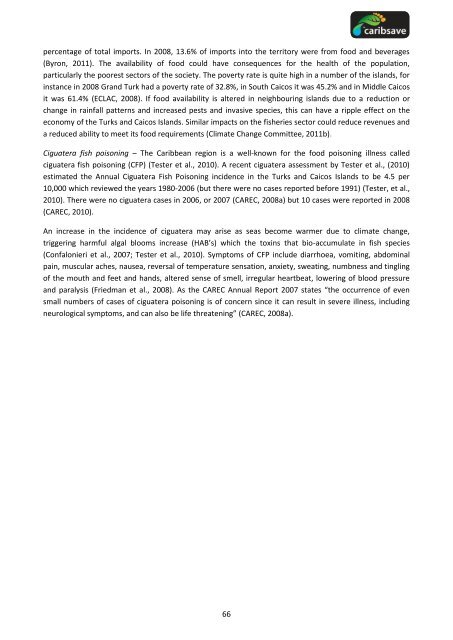Create successful ePaper yourself
Turn your PDF publications into a flip-book with our unique Google optimized e-Paper software.
percentage of total imports. In 2008, 13.6% of imports into the territory were from food <strong>and</strong> beverages<br />
(Byron, 2011). The availability of food could have consequences for the health of the population,<br />
particularly the poorest sectors of the society. The poverty rate is quite high in a number of the isl<strong>and</strong>s, for<br />
instance in 2008 Gr<strong>and</strong> Turk had a poverty rate of 32.8%, in South <strong>Caicos</strong> it was 45.2% <strong>and</strong> in Middle <strong>Caicos</strong><br />
it was 61.4% (ECLAC, 2008). If food availability is altered in neighbouring isl<strong>and</strong>s due to a reduction or<br />
change in rainfall patterns <strong>and</strong> increased pests <strong>and</strong> invasive species, this can have a ripple effect on the<br />
economy of the <strong>Turks</strong> <strong>and</strong> <strong>Caicos</strong> Isl<strong>and</strong>s. Similar impacts on the fisheries sector could reduce revenues <strong>and</strong><br />
a reduced ability to meet its food requirements (Climate Change Committee, 2011b).<br />
Ciguatera fish poisoning – The Caribbean region is a well-known for the food poisoning illness called<br />
ciguatera fish poisoning (CFP) (Tester et al., 2010). A recent ciguatera assessment by Tester et al., (2010)<br />
estimated the Annual Ciguatera Fish Poisoning incidence in the <strong>Turks</strong> <strong>and</strong> <strong>Caicos</strong> Isl<strong>and</strong>s to be 4.5 per<br />
10,000 which reviewed the years 1980-2006 (but there were no cases reported before 1991) (Tester, et al.,<br />
2010). There were no ciguatera cases in 2006, or 2007 (CAREC, 2008a) but 10 cases were reported in 2008<br />
(CAREC, 2010).<br />
An increase in the incidence of ciguatera may arise as seas become warmer due to climate change,<br />
triggering harmful algal blooms increase (HAB’s) which the toxins that bio-accumulate in fish species<br />
(Confalonieri et al., 2007; Tester et al., 2010). Symptoms of CFP include diarrhoea, vomiting, abdominal<br />
pain, muscular aches, nausea, reversal of temperature sensation, anxiety, sweating, numbness <strong>and</strong> tingling<br />
of the mouth <strong>and</strong> feet <strong>and</strong> h<strong>and</strong>s, altered sense of smell, irregular heartbeat, lowering of blood pressure<br />
<strong>and</strong> paralysis (Friedman et al., 2008). As the CAREC Annual Report 2007 states “the occurrence of even<br />
small numbers of cases of ciguatera poisoning is of concern since it can result in severe illness, including<br />
neurological symptoms, <strong>and</strong> can also be life threatening” (CAREC, 2008a).<br />
66





